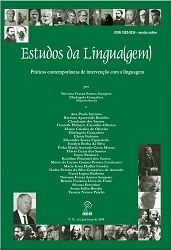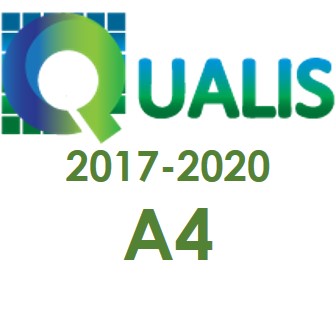Fluency in the speech pathology clinic: a heterogeneous and multifacted concept
DOI:
https://doi.org/10.22481/el.v17i1.5317Keywords:
Language; Fluency; Neurolinguistic.Abstract
This paper discusses different conceptions of fluency in Linguistics, Speech Therapy and Neuropsychology. The text indorses that fluency should be considered from its multifactorial character and heterogeneous condition in the language clinic. Language data are analyzed according to the Enunciative-Discursive Neurolinguistics, considering three clinical cases: stuttering, primary progressive aphasia and Alzheimer's dementia. Thus, it is observed that the concept of fluency is constructed in a particular way in the areas of Linguistics, Speech-Language Pathology and Neuropsychology. Also it is observed that the interpretation of fluency in each one of them is not presented in a uniform way as it is not a completed concept; for that reason, it emphasizes the need for reflection on the fluency as an inherent aspect of the language in its various possible norms.
Downloads
References
ANTUNES, E. B. et al. Afasia progressiva primária e variantes. Revista da Faculdade de Ciências da Saúde, n.7, p. 282-293, 2010.
BAKHTIN, M. M. Marxismo e filosofia da linguagem: problemas fundamentais do método sociológico na ciência da linguagem. 14. ed. São Paulo: Hucitec, 2010.
BARROS, D. L. P. Procedimentos e recursos discursivos da conversação. In: PRETI, D. (Org.). Fala e escrita em questão. São Paulo: Humanitas, 2006. p. 47-70. 3 v.
BECKER, N. et al. Estratégias de evocação lexical com critério semântico em adultos após acidente vascular cerebral no hemisfério direito. Letrônica, v. 7, n. 1, p. 325-347, 2014.
BRADAC, J. J.; KONSKY, C. W.; ELLIOTT, N. D. Verbal behavior of interviewees: The effects of several situational variables on verbal productivity, disfluency, and lexical diversity. Journal of communication disorders, v. 9, n. 3, p. 211-225, 1976.
CLARK, D. G. et al. Fluent versus nonfluent primary progressive aphasia: a comparison of clinical and functional neuroimaging features. Brain and language, v. 94, n. 1, p. 54-60, 2005.
COUDRY, M. I. H. Diário de Narciso: Discurso e Afasia. Análise de interlocuções com afásicos. São Paulo: Martins Fontes, 1988-2001.
FILLMORE, C. J. On fluency. In: ______.; KEMPLER, D.; WANG, W. S. Y. (Ed.). Individual differences in language ability and language behavior. New York: Academic Press, 1979. p. 85-101.
FRIDRIKSSON, J. et al. Damage to the anterior arcuate fasciculus predicts non-fluent speech production in aphasia. Brain, v. 136, n. 11, p. 3451-3460, 2013.
FRIEDMAN, S. A construção do personagem bom falante. São Paulo: Summus, 1993-1994.
______. Fluência de Fala: Um acontecimento complexo. In: FERNANDES, F. D. M.; MENDES, B. C. A.; NAVAS, A. L. G. P. (Org.). Tratado de fonoaudiologia. 2. ed. São Paulo: ROCA, 2010.
GOLDMAN-EISLER, F. Speech analysis and mental processes. Language and Speech, v. 1, n. 1, p. 59-75, 1958.
GOODGLASS, H. Linguistic aspects of aphasia. Trends in Neurosciences, v. 6, p. 241-243, 1983.
______. Understanding aphasia. San Diego: ACademic Press, 1993.
GORDON, J. K. The fluency dimension in aphasia. Aphasiology, v. 12, n. 7-8, p. 673-688, 1998.
JAKOBSON, R. Linguística e comunicação. 22. ed. São Paulo: Cultrix, 1963-2010.
KOCH, I. G. V.; SOUZA e SILVA, M. C. P. Atividades de composição do texto falado: a elocução formal. In: ILARI, R. (Org.). Gramática do português falado. 3. ed. Campinas: Ed. da Unicamp, 1996. p. 379-410.
LUTZ, K. C.; MALLARD, A. R. Disfluencies and rate of speech in young adult nonstutterers. Journal of Fluency Disorders, v. 11, n. 4, p. 307-316, 1986.
MARCOLINO, J. F. As categorias" fluente" e" não fluente" na afasia. Revista lael em discurso, v. 2, n. 1, p. 109-124, 2010.
MARSHALL, J. C. The description and interpretation of aphasic language disorder. Neuropsychologia, v. 24, n. 1, p. 5-24, 1986.
MARSHALL, R. C.; TOMPKINS, C. A. Verbal self-correction behaviors of fluent and nonfluent aphasic subjects. Brain and Language, v. 15, n. 2, p. 292-306, 1982.
MERLO, S. Algumas Reflexões Sobre o Conceito de Fluência. In: ROCHA, E. M. N. Gagueira: Um distúrbio de fluência. São Paulo: Santos, 2007.
MESULAM, M. M. Slowly progressive aphasia without generalized dementia. Neurology, v. 11, n. 6, p. 592-598, 1982.
MORATO, E. M. As querelas da semiologia das afasias. In: ______. A semiologia das afasias: perspectivas linguísticas. São Paulo: Cortez, 2014. p. 23-47.
NOVAES-PINTO, R. C. O conceito de fluência nos estudos das afasias. Cadernos de Estudos Linguísticos, v. 54, n. 1, p. 118-134, 2012.
______.; SANTANA, A. P. Semiologia das afasias: uma discussão crítica. Psicologia: Reflexão e Crítica, Porto Alegre, v. 22, n. 3, p. 413-421, 2009.
SANTANA, A, P; SANTOS, K. P. BERBERIAN, A. P.; MARTINS, D. F. Letramento e Demência de Alzheimer. In: MOURA, H. et al. Cognição, léxico e gramática. Florianópolis: Insular, 2012. p. 155-173.
______.; A perspectiva enunciativo-discursiva de Bakhtin e a análise da linguagem na clínica fonoaudiológica. Bakhtiniana, São Paulo, v. 12, n. 2, p. 174-190, maio/ago. 2017.
SANTOS, K. P. dos. A fluência em questão: da normalidade á patologia. 2015. 240 f. Dissertação (Mestrado) - Programa de Pós-Graduação em Linguística, Universidade Federal de Santa Catarina, Florianópolis, 2015.
______.; RIBEIRO, D. C.; SANTANA, A. P. Fluency in primary progressive aphasia-logopenic variant. Audiology-Communication Research, v. 20, n. 3, p. 285-291, 2015.
_____.; SANTANA, A. P. Teste de Fluência Verbal: uma revisão histórico-crítica do conceito de fluência. Distúrbios comun, v. 27, n. 4, p. 807-818, 2015.
SCARPA, E. M. (Ainda) sobre o sujeito fluente. In: LIER-DE-VITTO, M. F.; ARANTES, L. (Org.). Aquisição, Patologias e Clínica de Linguagem. São Paulo: Educ (PUC-SP), 2006. p. 161-180.
______.; SVARTSMAN, F. A estrutura prosódica das disfluências em português brasileiro. Cadernos de Estudos Lingüísticos, v. 54, n. 1, p. 26-40, 2012.
SCHIEFER, A. M. Aspectos Psicolínguísticos da Gagueira. In: FERNANDES, F. D. M.; MENDES, B. C. A.; NAVAS, A. L. G. P. (Org.). Tratado de fonoaudiologia. 2. ed. São Paulo: ROCA, 2010. p. 449-453.
TAYLOR, I. Content and structure in sentence production. Journal of Verbal Learning and Verbal Behavior, v. 8, n. 2, p. 170-175, 1969.
THURSTONE, L. L. Psychological implications of fator analysis. American Psychologist, v. 3, n. 9, p. 402-408, 1947.
VAN RIPER, C. Stuttering? Journal of Fluency Disorders, v. 17, n. 1, p. 81-84, 1992.
VIEIRA, A. C. C. et al. Afasias e áreas cerebrais: argumentos prós e contras à perspectiva localizacionista. Psicologia: Reflexão e Crítica, v. 24, n. 3, p. 588-596, 2011.
WINGATE, M. E. Fluency and disfluency; illusion and identification. Journal of fluency disorders, v. 12, n. 2, p. 79-101, 1987.
______. Fluency, disfluency, dysfluency, and stuttering. Journal of Fluency Disorders, v. 9, n. 2, p. 163-168, 1984.
Downloads
Published
How to Cite
Issue
Section
License

Estudos da Língua(gem) is licensed under a Creative Commons Attribution 4.0 International License.
Authors who publish in the journal Estudos da Língua (gem) agree with the following terms:
The journal Estudos de Língua(gem) maintains the copyrights of the contributions published. These rights include the publication of the contribution and make its content available for free through the portal.







